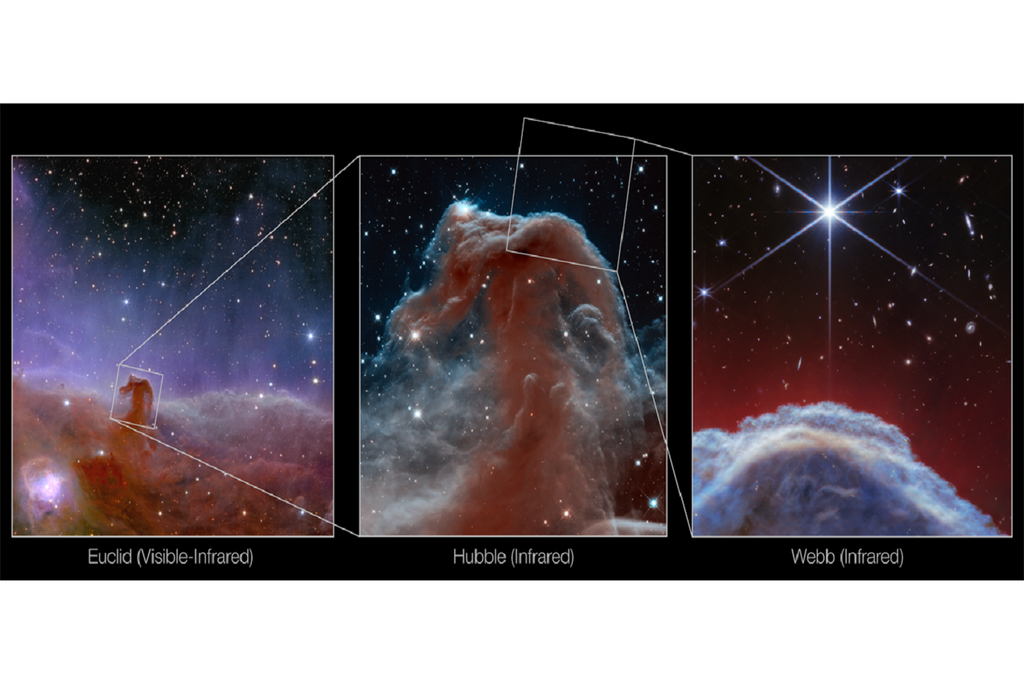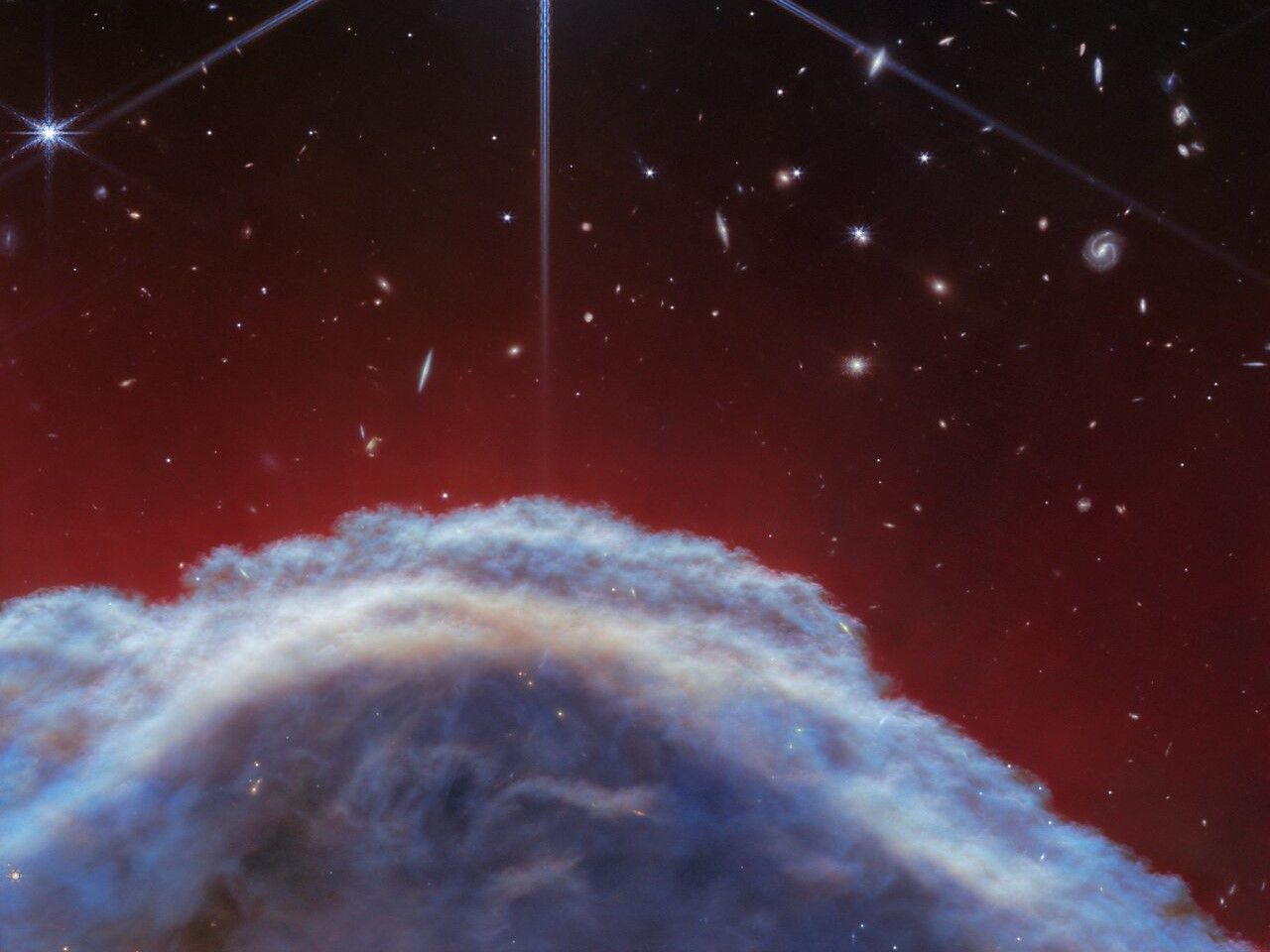The James Webb Space Telescope was able to take a picture The clearest infrared images yet One of the most distinctive objects in our sky, Horsehead Nebula. These observations show part of the iconic nebula in a whole new light, illustrating its complexity with unprecedented spatial resolution.
It was used by a team of astronomers Combination of 23 filters for exceptional accuracy. They were able to track emissions from grains smaller than 20 nanometers in diameter, including interstellar polycyclic aromatic hydrocarbon molecules, as well as light scattered by larger grains and ionized hydrogen present in the cloud.
horsehead nebula, It was given this name because of its resemblance to a horse's head, and is located about 1,300 light-years away. It is part of the Orion molecular cloud complex and is filled with dust and gas so dense that it appears as a dark hole in the bright gas surrounding it.
Observations that were submitted and accepted in an article for the journal Astronomy and Astrophysics Published on arXiv, revealed never-before-seen features in the Horsehead Nebula. In detail, The telescope magnified the area above the head the horse “, Capture tendrils and threads with amazing precision.
Horsehead Nebula: yes or no?
The Horsehead Nebula is famous for looking like a horse's head. Webb captured the top of the Horse's Mane, giving us the clearest infrared images of the area to date: https://t.co/2SDdbAOkYM pic.twitter.com/0zWxukU4EA
– NASA Webb Telescope (@NASAWebb) April 29, 2024
Nebulae and the “nursery” of stars
New images show a patch of sky in the constellation Orion, on the western side of the Orion B molecular cloud, emerging from turbulent waves of dust and gas. It is the Horsehead Nebula, also known as Barnard 33It is located about 1,300 light-years away.
Nebula They formed from a cloud of collapsed interstellar material and glow because they are illuminated by a hot nearby star.. The gas clouds surrounding the horse's head have already dissipated, but the protruding column is made of thick blocks of material that is difficult to corrode.
Astronomers estimate this This structure had about five million years left before it also disintegrated.. Webb's new view focuses on the bright edge of the upper part of the nebula's distinctive structure of dust and gas.
It is a photon-dominated region, or PDR. In such an area, Ultraviolet radiation from young, massive stars creates a space of gas and dust Most of it is neutral and warm among the fully ionized gas surrounding massive stars and the clouds in which they were born.
Amazing look
When we observe them at wavelengths outside the range of normal human vision, Its appearance transforms from a dark void into a bright, rising cloud.. This ultraviolet radiation strongly affects the gas chemistry in these regions and acts as the most important source of heat.
These areas occur where eInterstellar gas is dense enough to remain neutralBut they are not dense enough to prevent the penetration of far-UV radiation from massive stars.
Emitted light For such a popular democracy It provides a unique tool to study the physical and chemical processes that drive the evolution of interstellar matter In our galaxy and throughout the universe from the early era of vigorous star formation to the present day.
Due to its proximity and almost geometric shape, It is an ideal target for astronomers to study the physical structures of PDRs The evolution of the chemical properties of gas and dust within their respective environments, and the transitional regions between them.
Ultraviolet rays are not only harmful to human skin
However, the intense radiation from the stars surrounding the nebula has a devastating effect on its environment. Far ultraviolet light causes a process called photodissociation, in which molecules break apart. Under the influence of strong rays.
this It creates a mostly neutral interstellar field around the Horsehead Nebula. This photodissociation region will be explored in more detail thanks to images taken by the James Webb Space Telescope (JWST).

the Recent observations could be key to clarifying the phenomenon of photoevaporationa process in which the gas is ionized by intense radiation and effectively dissipated.
up to date, Small formations have been identified that adorn the glowing borders of the nebula, as well as a weave of threads that extend at right angles to the edge of the PDR. This framework contains dust and gas, which are essential components of the photoevaporation flux.
More detailed notes
This nebula does not contain an internal light source, however It is heated by a nearby collector called Sigma Orionis. It is a system of very young, large, and hot stars that shine at temperatures of about 34,600 Kelvin.
A combination of these features It makes an excellent laboratory for understanding stellar nurseries. Inside the “Horsehead” we find small stars in the process of formation, protected from our view by the dust itself.
however, These results are just the beginning.. The next stage includes a careful examination of the radiation emitted Detect the chemical composition of particles and gasIn addition to the size and dynamics of dust grains based on light scattering.
This process will facilitate the construction of an accurate model of dust transformation in PDR and will provide specialists with a better understanding of dust transformation The transformation and disintegration of these clouds, finally Make room for the young stars that lie within.





